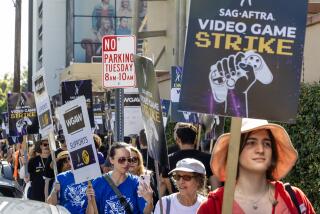Hollywood talks expected to be less acrimonious this time
One thing is certain when representatives of Hollywoodâs actors unions sit down with their studio counterparts this month: There will be a lot less drama in the room.
A new leadership, a detente between once-warring actors unions, and a reluctance on both sides to engage in another bargaining standoff in a dour economy suggest that the next round of contract negotiations will be far less acrimonious than two years ago.
âPeople have fresh in their minds what the cost of a long conflict is,â said Dan Mitchell, a professor of management and public policy at UCLA.
The 120,000-member Screen Actors Guild has adopted a decidedly low-key approach to the upcoming negotiations for a new prime-time TV and film contract, eschewing public pronouncements about its goals and agenda for talks set to begin Sept. 27.
Likewise, the Alliance of Motion Picture and Television Producers, the chief bargaining arm of the studios, has remained mum in advance of the seven weeks of talks.
Although the actorsâ contracts donât expire until June 2011, the unions agreed to negotiate nine months early to avoid the kind of showdown that doomed previous talks, when the Screen Actors Guild clashed with studios and mounted a public campaign to discredit contract terms agreed to by its smaller sister union, the American Federation of Television and Radio Artists.
This time, the two unions that previously broke ranks have restored relations and resumed joint bargaining. Whatâs more, union insiders say, they are eager to show that they can expand their partnership to pave the way for an eventual merger, which has been declared a top goal of SAG President Ken Howard and his supporters.
On Sunday, the joint board of SAG and AFTRA approved a package of proposals after weeks of meetings nationwide with their members.
Although neither union would comment on the proposals, people close to the groups said they reflect a pragmatic agenda. While previous talks centered around the Internet and how actors would be paid across various new media outlets, the upcoming talks are expected to focus mainly on traditional bread-and-butter issues, such as boosting minimum pay.
One major goal is to reverse so-called salary compression that has squeezed the incomes of actors, who struggle to get their âquotesâ and typically work at or close to the union minimum. Actors have seen a steady decline in TV residuals â the fees they fetch from reruns â from fewer shows repeating on networks or later sold into syndication.
Another priority is to raise contributions to the unionsâ health and pension plans that have been buffeted by investment losses during the recession, rising medical expenses and, in SAGâs case, a loss in revenue as more actors split their earnings between the two unions. That trend has rapidly accelerated in recent years as TV producers chose AFTRA for new prime-time TV shows, perceiving the union to be more accommodating.
SAGâs health plan, facing a $30-million deficit this year, notified members this week that it will be raising premiums and cutting benefits.
SAGâs Howard has not only worked to mend fences with AFTRA but has also taken a far less confrontational approach with the studios than his predecessor Alan Rosenberg, who led the union during the yearlong logjam with the studios that created widespread instability on the heels of 100-day strike by writers in 2007-2008.
The fallout triggered a revolt in SAGâs boardroom, now dominated by a coalition of so-called moderates backed by the likes of Tom Hanks and George Clooney, and led to the firing of former executive director, Doug Allen.
He was replaced by former SAG general counsel David White, who, like Howard, has sought to project a calmer image of Hollywoodâs famously unruly union. The two men, and their counterparts at AFTRA, have had several informal discussions with studio representatives in preparation for the talks.
Howard will co-chair the negotiation committee with his counterpart at AFTRA, Roberta Reardon, while White and AFTRA Executive Director Kim Roberts Hedgpeth will serve as chief negotiators.
âWe know both sides will come to this negotiation focused on their own interests,â Howard said. âBut itâs our job to represent a big labor force thatâs having a very tough time making ends meet. Itâs not a matter of being at loggerheads, but of working in good faith to find common ground.â
Howardâs tougher task, however, may be to find a way to appease a sizeable and vocal minority within SAG that supported Rosenberg and Allen and views the current leadership as too close to management. âIf we get to an impasse, under no circumstances do I believe this group has the stomach to call for a work stoppage,â said former board member George Coe, who is also a member of the guildâs negotiating committee.
Reardon said her union, which shares 44,000 actor members in common with SAG, was ready to secure an agreement by mid-November. âWe have every expectation to go in there and get our work done,â said Reardon, adding that her union has three other contracts to negotiate, covering work in video games, industrial training videos and talk shows.
âBoth sides will have to confront some complex and difficult issues in the upcoming talks,â said Jesse Hiestand, spokesman for the Alliance of Motion Picture and Television Producers. âEarly negotiations will give us the best opportunity to work through these challenges productively and reach a deal that is fair and keeps everyone working.â
How amenable studios will be to granting any pay hikes during a period of austerity remains unclear. They did recently grant 2% pay increases and other concessions to studio drivers after Teamsters threatened a walkout.
More to Read
The biggest entertainment stories
Get our big stories about Hollywood, film, television, music, arts, culture and more right in your inbox as soon as they publish.
You may occasionally receive promotional content from the Los Angeles Times.











